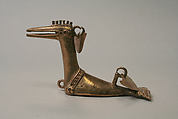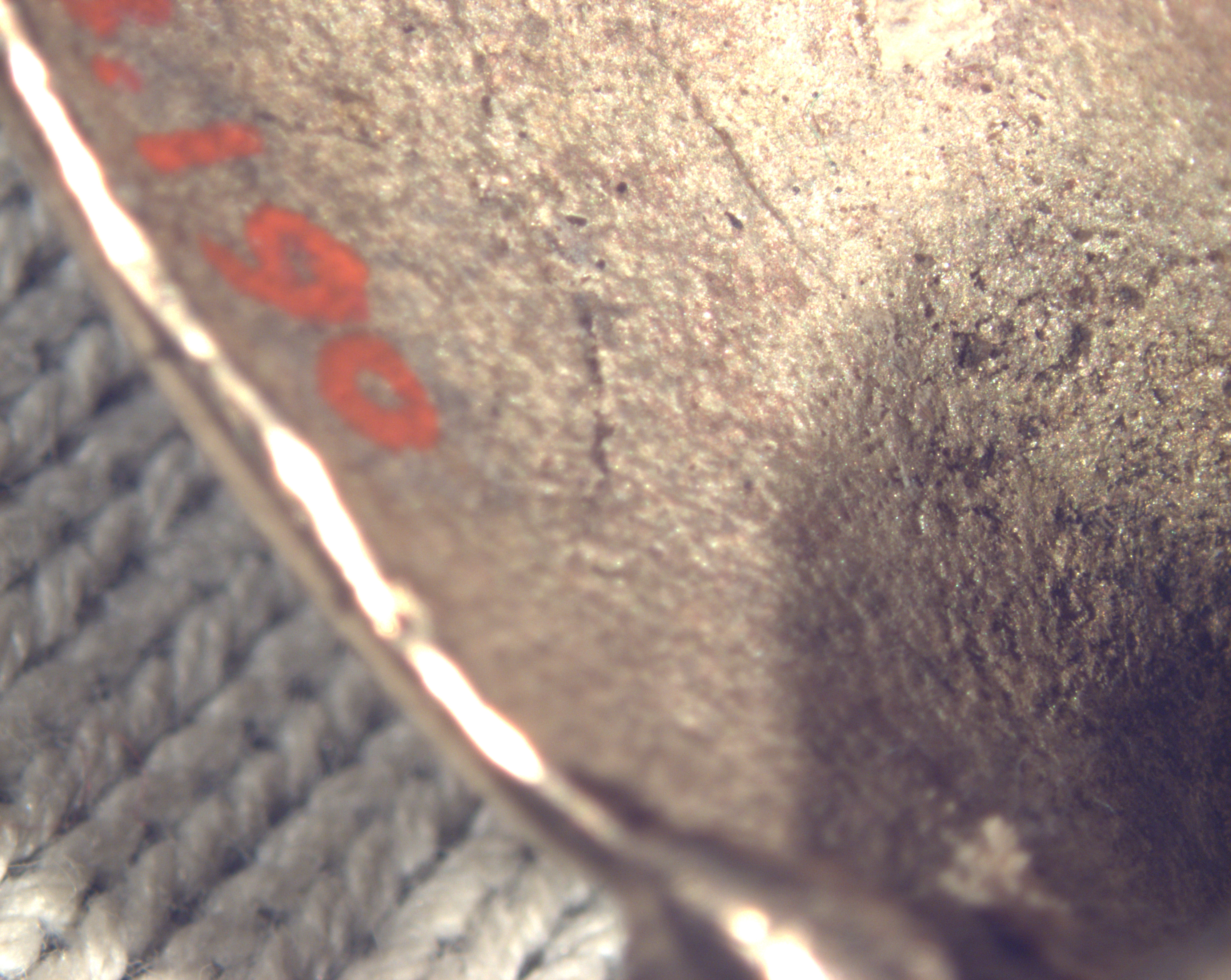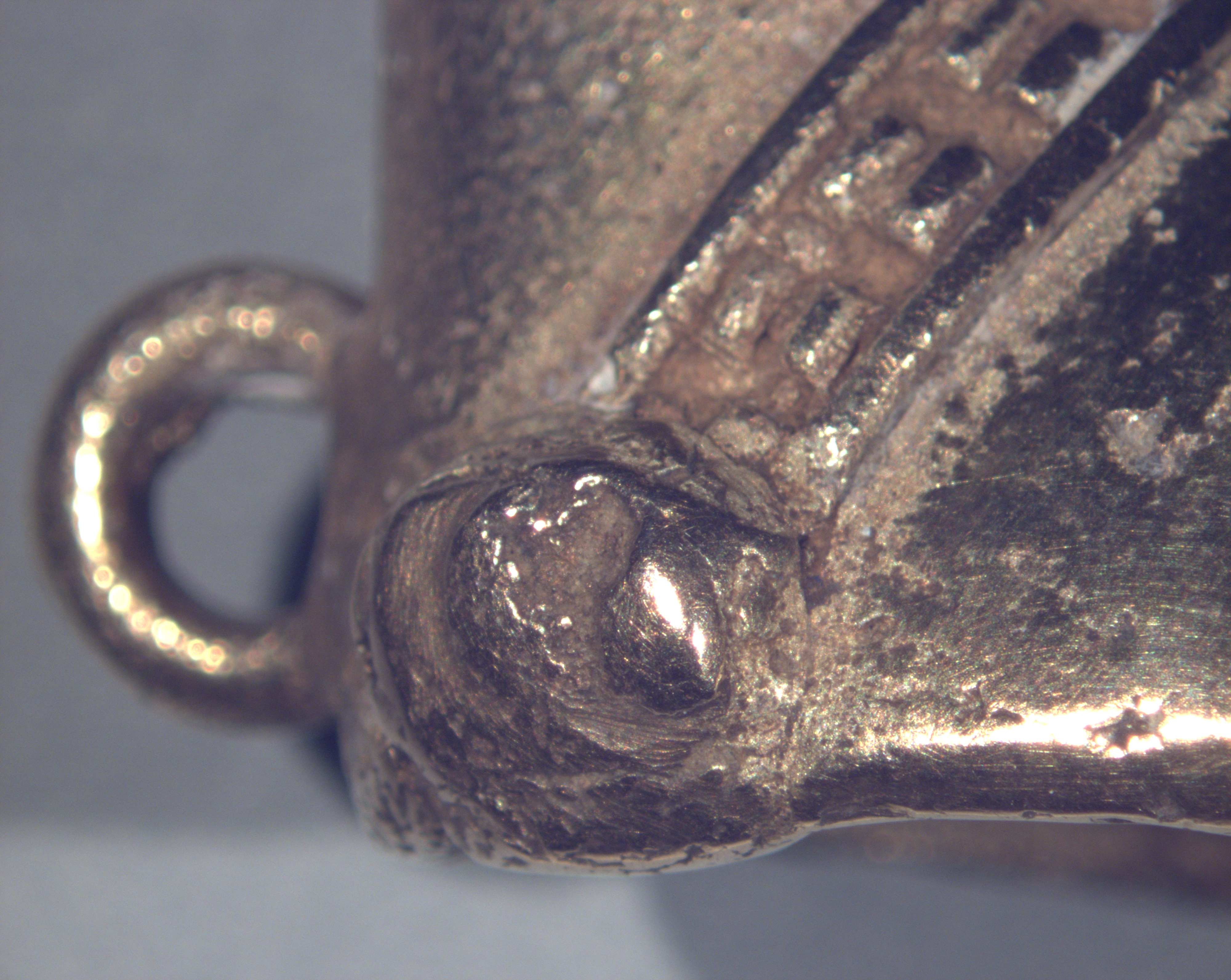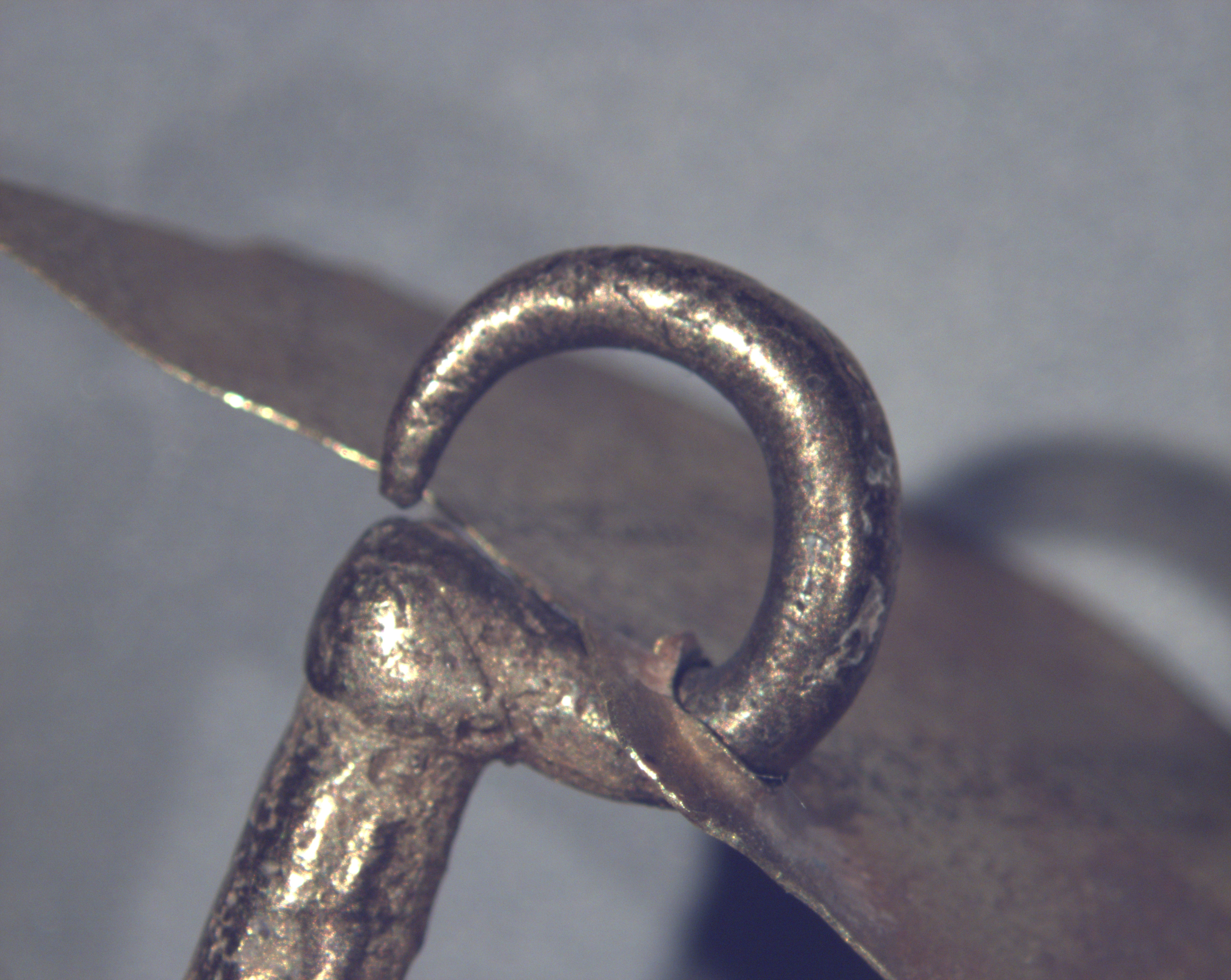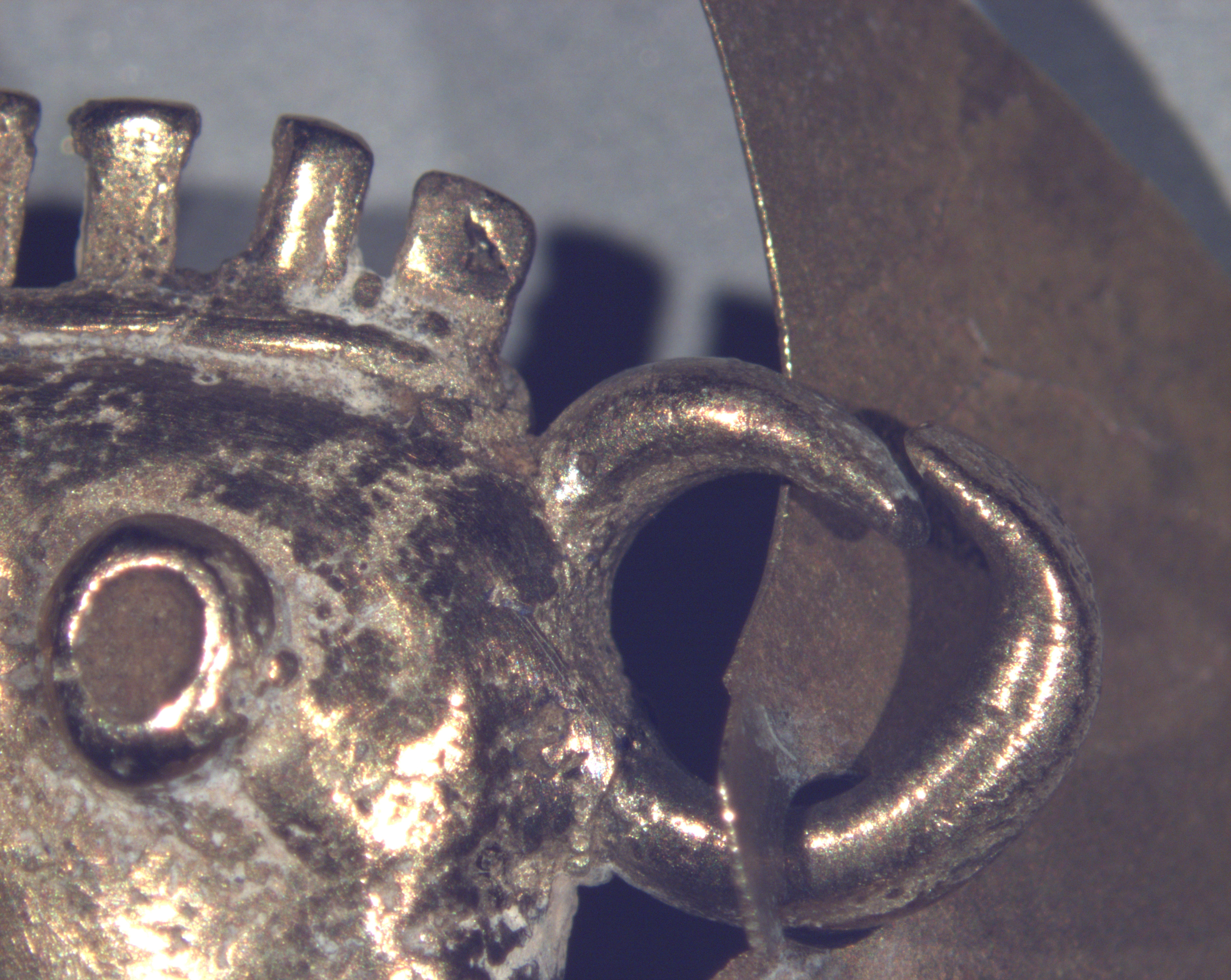Bird Pendant
Not on view
Technical note: Optical microscopy and XRF conducted in 2017.
This pendant in the shape of a bird was primarily produced through lost wax casting. Made of an alloy of gold, it depicts a stylized bird with identifying features of a head, neck, body, and tail. The lower areas of the bird, its abdomen and limbs, are not shown. Depicting the bird in this way suggests that it is "posad[a] en agua" ("at rest in water"), as Pérez de Barradas (1966, 106) inferred for a similar avian pendant. All of the design features of this pendant were originally made in the wax except for the two crescent-shaped danglers, which were made separately from hammered sheet and added after casting. The underside of the bird reveals that the object was open-back-cast (see image 2). A ceramic-charcoal core that gave the object its basic shape was enclosed in wax, but one side (the underside) was left exposed. When the ceramic investment was built around the wax model, it came into contact with the exposed core, fusing with it to form a stabilizing structure in and around the cast metal. The cavity that once contained the core extends from the head of the bird up to but not including the tail. Other features are indicative of the casting process. There are remains of a sprue—used to channel molten metal into the mold—on the proper left side of the bird (see image 3). However, this feature also may relate to the presence of a bar that would have connected this bird to another, forming a pair, similar to other objects in this corpus. Another possible sprue is seen at the end of the tail visible from the underside.
The beak of the bird is prominently featured; its length further suggests it is a water bird. Its mouth is open and, when making the wax model, the artists used a wire-like wax thread to outline the mouth. There is a circular eye on each side of the head with a small circular depression at its center representing the pupil. The bird has a crest, comprised of six blunt-ended projections of metal extending vertically from the top of the head (see image 4). The bird is adorned with a necklace created by two continuous bands with repeating pairs of rectangles, probably representing beads, between these bands (see image 3). This feature is similar to other motifs on Quimbaya—not to mention Isthmian—animal and human figurines (cf. the beaded necklace and ligatures at the wrists and knees on 1991.419.22) that may represent necklaces made of stone or metal beads. The tail is an unusual design for Quimbaya bird pendants. More typically, the body will taper and then connect with two spiral motifs (cf. Museo del Oro (Bogotá) O3090 and Dumbarton Oaks PC.B.396). In this instance the tail is triangular with five depressed lines across the top.
The pendant has one loop at the front of the chest for purposes of suspension. It also has two looped hooks on the backside of the bird’s body for the attachment of the two sheet danglers. One hook is directly attached to the back of the head (see image 4), while the other, attached to a stem, is located near the tail (see image 5). The hooks have a small openings to attach the danglers. The thickness of the danglers ranges between 1 mm and 1.8 mm, and they are approximately 25 mm in diameter.
This object belongs to a corpus of Quimbaya bird pendants that includes pairs of birds joined at the base of their necks e.g., Museo del Oro (Bogotá) O3093, MO O3097, MO O3090 in Pérez de Barradas 1965, pls. 59–60, all of which are from Quindío or Caldas. Similar pendants but without provenance include MO O6041, MO O643, MO O6045 (all in Pérez de Barradas 1965, pls. 82, 85) and Dumbarton Oaks PC.B.396.
Birds are a common theme in early goldworking from Colombia. Interestingly, there is a range of avian pendants from San Pedro de Urabá, often showing two birds connected at their bodies and/or their tails (Uribe 1988, pl. 8). From the same site, a much larger avian pendant includes two rows of three square danglers each, and the top row hangs from the bird’s beak (Museo del Oro (Bogotá) O32654; Uribe 1988, pl. 9); the danglers obscure most of the bird’s body. Objects similar to the present example often have been interpreted as tools of religious practitioners, notably shamans, drawing on ethnography from the region of Central America and Colombia. Identifying birds as "shamanic animals par excellence," Reichel Dolmatoff (1988, 21–22, 66) suggests that the danglers of objects can induce hypnotic effects, citing a Kuna or Gunadule shaman who employed a "stick covered with a larger number of tiny mirrors embedded in a pitch base" in his transformative practices. Drawing on Talamanca ethnographies, Aguilar (1996, 34, 46) infers that the danglers on pendants "presentan quiebres de luz y sonido, lo que facilita la comunicación mística entre el hombre, el chamán y los espíritus" ("present ruptures in light and sound, facilitating the mystical communication among man, shaman, and sprits"). Indeed, it is important to consider the sound and movement of this object. The pendant is designed so that the dangles create a faint clinking sound when they strike the metal of the bird. One can imagine that the piece was designed to make sound when worn. In any case, an interpretation of this object as part of religious practice should not foreclose recognition that metal and metal objects may have been available to a wide array of people in the Quimbaya region, not only people in shamanic roles, as Langebaek (2003) has noted especially for Muisca and Tairona societies, or that metal was perceived as a commodity or natural resource, as suggested by Gaitán (2006) and as it may be by the mining communities, or barequerxs, of Antioquia today (Castillo 2007).
The metalworking from Urabá shows some similarities to the Quimbaya tradition, especially in terms of anthropomorphic pendants, and to Isthmian traditions. The carbonized core of a double mammalian Quimbaya pendant (MO O6039) was dated through radiocarbon analysis to suggest the object was fabricated in 190 +/- 40 AD (Beta-108843) (Plazas 1998). This pendant and the avian pendant discussed here were part of the Initial Group of metalwork in the region of Central America and Colombia, in which objects were produced in the Urabá and Quimbaya traditions, among others, and exported toward the Isthmus, serving as points of reference for early metallurgists there. Quimbaya metalworkers lived in dispersed settlements in the Middle Cauca Valley, practicing maize agriculture and locally mining salt and gold (Uribe 2005).[1]
Bryan Cockrell, Curatorial Fellow, Arts of Africa, Oceania, and the Americas
Beth Edelstein, Associate Conservator, Objects Conservation
Ellen Howe, Conservator Emerita, Objects Conservation
Caitlin Mahony, Assistant Conservator, Objects Conservation
2017
[1] Today, alluvial gold mining continues among communities in the Cauca Valley, who hold their lands "en común" ("in common") and where women specialize in gold extraction and men help when they are not involved in selling gold, working on large farms, or cultivating maize (Castillo 2007). However, the region also has been the site of explorations by foreign and illegal mining projects with retro-excavators. In 2014, Afro-Colombian women from the northern part of the Cauca department, farther south along the course of the Cauca River, marched to Bogotá to demand the end of illegal mining projects in their territories (Mina Rojas et al. 2015). The women occupied the Ministry of the Interior and won commitment from the government that it would ban illegal mining.
Related Objects: 1979.206.529, 1979.206.554, 1979.206.776, 1991.419.22, 1991.419.27
Exhibitions: MPA Precolumbian Gold Sculpture, exhibit 6, Oct. 29, 1958–Feb. 8, 1959, checklist no. 38; Scarsdale, NY, Scarsdale Studio Workshop, Precolumbian Gold and Jade, Jan. 18–20, 1964; MPA Masterpieces from the Americas, exhibit 35, May 20–Nov. 11, 1964, not on checklist; MPA The World of Primitive Art, exhibit 43, July 12–Sept. 11, 1966, no catalogue; MMA Art of Oceania, Africa, and the Americas from the Museum of Primitive Art, May 10–Aug. 17, 1969, not in catalogue, extended to Sept. 1; Leningrad, Hermitage Museum, Gold of Precolumbian America, loan exhibition from MMA to Ministry of Culture, USSR, Aug. 4–Oct. 1, 1976; Moscow, The State Museum of Representational Arts, Oct. 15–Dec. 15, 1976; The Kiev State Historical Museum, Jan. 5–Mar. 1, 1977, cat. no. 107, ill.
References
Rivet, Paul. "L'orfèvrerie colombienne (technique, aire de dispersion, origine)." In Proceedings of the 21st International Congress of Americanists. The Hague, 1924, p. 28, no. 13.
Further reading
Aguilar Piedra, Carlos H. Los usékares de oro. San José: Fundación Museos Banco Central, 1996.
Castillo, Neyla. "Minería aurífera: Etnografía de las formas materiales y simbólicas en el noroeste andino de Colombia." In Metalurgia en la América antigua: Teoría, arqueología, simbología y tecnología de los metales prehispánicos, edited by Roberto Lleras Pérez, 281–321. Bogotá: Fundación de Investigaciones Arqueológicas Nacionales, Banco de la República, 2007.
Gaitán Ammann, Felipe. "Golden Alienation: The Uneasy Fortune of the Gold Museum in Bogotá." Journal of Social Archaeology 6 (2006): 227–54.
Langebaek, Carl Henrik. "The Political Economy of Pre-Columbian Goldwork: Four Examples from Northern South America." In Gold and Power in Ancient Costa Rica, Panama, and Colombia, edited by Jeffrey Quilter and John W. Hoopes, 245–278. Washington, D.C.: Dumbarton Oaks Research Library and Collection, 2003.
Mina Rojas, Charo, Marilyn Machado, Patricia Botero, and Arturo Escobar. "Luchas por el territorio y el Buen Vivir en Colombia: Las mujeres negras en resistencia." ALAI 39, no. 501 (2015): 19–22.
Pérez de Barradas, José. Orfebreria prehispánica de Colombia: Estilos Quimbaya y otros. Bogotá: Banco de la República, 1966.
-----. Orfebrería prehispánica de Colombia: Estilos Quimbaya y otros: Láminas. Bogotá: Banco de la República, 1965.
Plazas, Clemencia. "Cronología de la metalurgia colombiana." Boletín del Museo del Oro 44v45 (1998): 3–77.
Uribe, María Alicia. "Introducción a la orfebrería de San Pedro de Urabá, una región del Noroccidente Colombiano." Boletín del Museo del Oro 20 (1988): 35–53.
-----. "Mujeres, calabazos, brillo y tumbaga: Símbolos de vida y transformación en la orfebrería Quimbaya Temprana." Boletín de Antropología Universidad de Antioquia 19, no. 36 (2005): 61-93.
Reichel-Dolmatoff, Gerardo. Goldwork and Shamanism: An Iconographic Study of the Gold Museum. Medellín: Compañía Litográfica Nacional S. A., 1988.
Due to rights restrictions, this image cannot be enlarged, viewed at full screen, or downloaded.
This artwork is meant to be viewed from right to left. Scroll left to view more.
